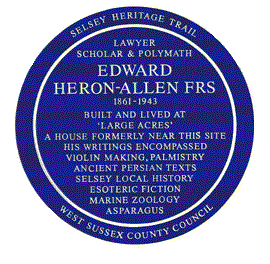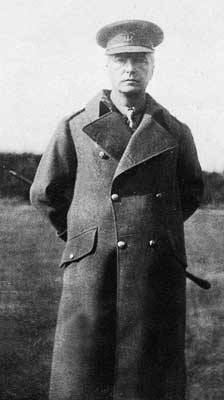Edward Heron-Allen facts for kids
Quick facts for kids
Edward Heron-Allen
|
|
|---|---|
 |
|
| Born | Edward Heron Allen (not hyphenated) 17 December 1861 London, England, United Kingdom |
| Died | 28 March 1943 (aged 81) Large Acres, Selsey, West Sussex, England, United Kingdom |
| Pen name | Christopher Blayre |
| Occupation | Lawyer, Scholar, Scientist |
| Education | Elstree School Harrow School |
| Genre | Persian Literature, Horror, Zoology, Local History, Foraminifera, Music |
| Subject | Various |
| Notable works | Violin-Making as it Was and Is, Manual of Cheirosophy, The Science of the Hand , Rubaiyat of Omar Khayyam, The Lament of Baba Tahir, Edward Heron-Allen's Journal of the Great War |
| Spouse | Marianna (died 1902) Edith Emily |
| Children | 2 daughters |
Edward Heron-Allen (born December 17, 1861 – died March 28, 1943) was a very talented English person. He was a writer, scientist, and expert in Persian language. He even translated famous Persian poems. He was known for knowing a lot about many different subjects.
Contents
Edward Heron-Allen's Life Story
Edward Heron-Allen was born in London, England. He was the youngest of four children. His parents were George Allen and Catherine Herring.
He went to Elstree School and then Harrow School starting in 1876. At school, he became very interested in old classical studies, science, and music. He especially loved playing the violin. Even though he didn't go to university, he learned a lot on his own.
In 1879, he started working at his family's law firm, Allen and Son. Their office was in Soho, London. This area was close to where many violin makers worked. Edward met a famous violin maker named Georges Chanot III. He learned how to make violins and even made some himself. Later, he wrote a book about making violins. This book was so good that people were still reading it over 100 years later!
Learning Languages and Palmistry
In 1885, Edward began studying the Turkish language. He learned from Garabet Hagopian, who was an Armenian diplomat in London. He also got help from Charles Wells, who was an expert in Turkish words.
Edward was also very skilled at palmistry, which is reading palms. He read the palms and looked at the handwriting of many famous people of his time. He wrote several books about palmistry. In 1886, he even went on a tour in the United States to give lectures about it.
When he came back from the USA, he went back to his law job in London. But he still found time to work on his other interests. One of these was studying the Persian language.
He became friends with Mirza Malkom Khan, a famous Persian Minister in London. In 1896, he learned everyday Persian from Mirza ʿAlinaqi. He was part of the Persian Legation, which is like an embassy. In 1897, he started studying with Edward Denison Ross. Ross was a professor of Persian at University College, London.
Edward published a direct translation of the Rubaiyat of Omar Khayyam in 1898. He used one of the oldest copies of the poem from the Bodleian Library. He continued to study and publish about different versions of the poem until 1908. He also translated a poem called "The Lament of Baba Tahir" in 1901. This poem was written in a less common Persian language called Luri.
Life in Selsey and World War I
In 1911, Edward's father passed away. After this, Edward stopped working as a lawyer. He moved permanently to Selsey in West Sussex, a town by the sea. There, he wrote a book about the history of Selsey. He also collected a huge library of 12,000 books. This included many rare books about violins. He later gave this collection to the Royal School of Music.
Edward was a big supporter of his local church, St Peter's Church in Selsey. He gave them a Church organ. This organ was built in 1912 and was given in memory of his late father.
Edward Heron-Allen also helped during World War I. He joined the Directorate of Military Intelligence (MI7b) in May 1918. He worked on aerial propaganda, which means he helped create messages spread by air. His journal from the war was published in 2002.
Scientific Work and Collections
Edward spent many years studying tiny sea creatures called foraminifera. These are very small, single-celled organisms with shells. Because of his important work, he was chosen to be a Fellow of the Royal Society in May 1919. This is a very high honor for a scientist in the United Kingdom.
Edward Heron-Allen gave his collections of foraminifera and his related books to the Natural History Museum, London. They are now kept in a special room at the museum. This room is called "The Heron-Allen Library" in his honor. The collection has his books, scientific papers, and even his notes. It also includes letters, photos, and other items related to his research.
Edward also wrote about many other topics. These included archaeology, which is the study of old cultures. He wrote about Buddhist philosophy and even how to grow and enjoy asparagus. He also wrote novels and short stories. Some of these were science fiction and horror stories. He used the pen name "Christopher Blayre" for these.
His horror and fantasy stories were some of the earliest examples of these types of fiction.
Awards and Memberships
Edward Heron-Allen received many honors and was a member of important groups:
- FRS 1919 – He was a Fellow of the Royal Society.
- FLS – He was a Fellow of the Linnean Society, which studies nature.
- FGS – He was a Fellow of the Geological Society, which studies Earth.
- FZS – He was a Fellow of the Zoological Society, which studies animals.
- FRMS – He was a Fellow of the Royal Microscopical Society, which studies things through microscopes.
- MRIrish Academy(Hon) – He was an Honorary Member of the Royal Irish Academy.
- Accademia Nazionale di Santa Cecilia – He was a Member of the Academy of St Cecilia in Rome. This is one of the oldest music schools in the world.
His Career Roles
Edward Heron-Allen held many different roles throughout his life:
- He became a Solicitor (a type of lawyer) in 1884.
- He was a special representative for the Music Section of the Colonial Exhibition in Italy in 1885.
- He gave lectures and wrote in the United States from 1886 to 1889.
- He was a student and lecturer on Protozoology, which is the study of tiny single-celled animals.
- He was a District Commissioner for the Boy Scouts in S.W. Sussex from 1910 to 1919.
- He was a District Commissioner for national service in S.W. Sussex from 1916 to 1917.
- He was a Lieutenant in the 6th Volunteer Battalion of the Royal Sussex Regiment in 1917.
- He worked with the Staff Intelligence Department at the War Office in 1918.
- He was the President of the Royal Microscopical Society from 1916 to 1918.
- He was an Honorary Member of the Manchester Microscopical Society.
- He was a Marine Biologist and Zoologist, studying sea life and animals.
- He was President of the Sette of Odd Volumes from 1927 to 1928.
- He was President of the National Auricula Society in 1928.



